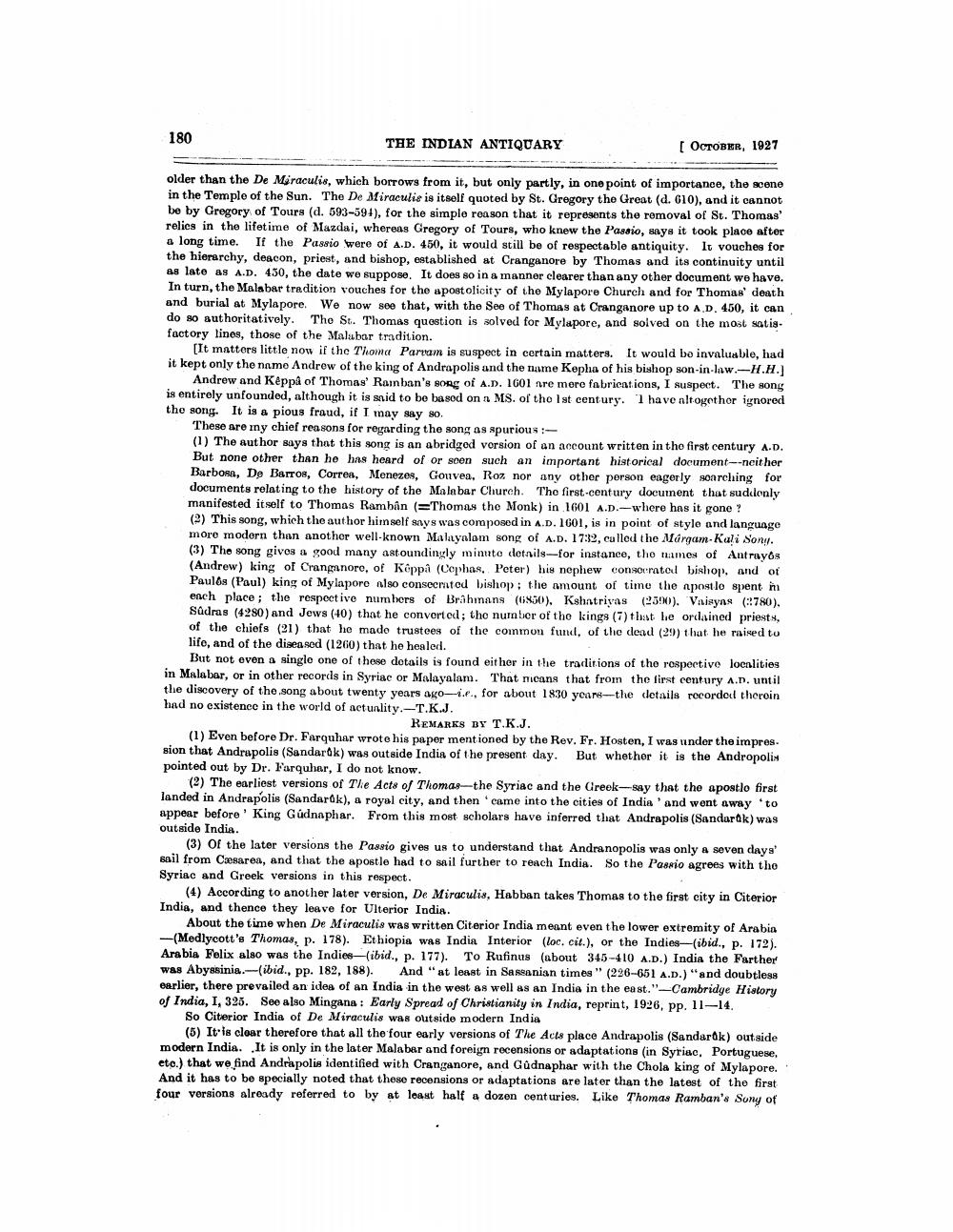________________
180
THE INDIAN ANTIQUARY
[ OCTOBER, 1927
older than the De Miraculis, which borrows from it, but only partly, in one point of importance, the scene in the Temple of the Sun. The De Miraculis is itself quoted by St. Gregory the Great (d. 610), and it cannot be by Gregory of Tours (d. 593-594), for the simple reason that it represents the removal of St. Thomas' relics in the lifetime of Mazdai, whereas Gregory of Tours, who knew the Passio, says it took place after a long time. If the Passio were of A.D. 450, it would still be of respectable antiquity. It vouches for the hierarchy, deacon, priest, and bishop, established at Cranganore by Thomas and its continuity until 18 late as A.D. 450, the date we suppose. It does so in a manner clearer than any other document we have. In turn, the Malabar tradition vouches for the apostolicity of the Mylapore Church and for Thomas' death and burial at Mylapore. We now see that, with the See of Thomas at Cranganore up to A.D. 450, it can do so authoritatively. The St. Thomas question is solved for Mylapore, and solved on the most satis. factory lines, those of the Malabar tradition.
[It matters little now if the Thoma Parvam is suspect in certain matters. It would be invaluable, had it kept only the name Andrew of the king of Andrapolis and the name Kepha of his bishop son-in-law.-H.H.]
Andrew and Keppå of Thomas' Ramban's song of A.1). 1601 nre mere fabrications, I suspect. The song is entirely unfounded, although it is said to be basod on a MS. of tho I st century. "I have altogether ignored the song. It is a pious fraud, if I may say so.
These are my chief reasons for regarding the song as spurious (1) The author says that this song is an abridged vorsion of an account written in the first century AD. But none other than he has heard of or seen such an important historical document--neither Barbosa, De Barros, Correa, Menezes, Gouvea, Roz nor any other person eagerly searching for documents relating to the history of the Malabar Church. The first-century document that suddenly manifested itself to Thomas Ramban (=Thomas the Monk) in 1601 A.D.-where has it gone ?
(2) This song, which the author himself says was composed in A.D. 1601, is in point of style and language more modern than another well-known Malayalam song of A.D. 17:32, called the Marga-Kali Song. (3) The song gives a good many astoundingly minuto details--for instance, tho names of Antrays (Andrew) king of Cranganore, of Koppa (Cephas. Peter) his nephew consorate bishop, and of Paulos (Paul) king of Mylapore also consecratod bishop: the amount of time the apostlo spent in ench place; the respective numbers of Brahmans (0850), Kshatriyas (2590). Vaisyne (780), Sadras (4280) and Jews (40) that he converted; the number of the kings (1) bat he ordained priests, of the chiefs (21) that he made trustees of the common fund, of the dead (29) that he raised to life, and of the diseased (1260) that he healed.
But not even a single one of these details is found either in the traditions of the respective localities in Malabar, or in other records in Syriac or Malayalam. That nieans that from the first century A.D. until the discovery of the song about twenty years ago-i.., for about 1830 years--the details recordou theroin had no existence in the world of actunlity. T.K.J.
REMARKS BY T.K.J. (1) Even before Dr. Farquhar wrote his paper mentioned by the Rev. Fr. Hosten, I was under the impres. sion that Andrapolis (Sandarák) was outside India of the present day. But whether it is the Andropolis pointed out by Dr. Farquhar, I do not know.
(2) The earliest versions of The Acts of Thomas-the Syriac and the Greek-say that the apostlo first landed in Andrapolis (sandarok), a royal city, and then came into the cities of India and went away to appear before 'King Gúdnaphar. From this most scholars have inferred that Andrapolis (Sandarák) was outside India
(3) Of the later versions the Passio gives us to understand that Andranopolis was only a seven days' sail from Caesarea, and that the apostle had to sail further to reach India. So the Passio agrees with the Syriac and Greek versions in this respect.
(4) According to another later version, De Miraculis, Habban takes Thomas to the first city in Citerior India, and thence they leave for Ulterior India.
About the time when De Miraculis was written Citerior India meant even the lower extremity of Arabia -(Medlycott's Thomas, P. 178). Ethiopia was India Interior (loc. cit.), or the Indies (ibid., p. 172). Arabia Felix also was the Indies (ibid., p. 177). To Rufinus (about 340-410 A.D.) India the Farther was Abyssinia.-(ibid., pp. 182, 188). And "at least in Saseanian times" (226-651 A.D.) "and doubtless earlier, there prevailed an idea of an India in the west as well as an India in the east."-Cambridge History of India, I, 325. See also Mingana: Early Spread of Christianity in India, reprint, 1926, pp. 11-14.
So Citerior India of De Miraculis was outside modern India
(5) It is clear therefore that all the four early versions of The Acts place Andrapolis (Sandarøk) outside modern India. It is only in the later Malabar and foreign recensions or adaptations in Syriac. Portuguese, etc.) that we find Andrapolis identified with Cranganore, and Gůdnaphar with the Chola king of Mylapore. And it has to be specially noted that these recensions or adaptations are later than the latest of the first four versions already referred to by at least half a dozen centuries. Like Thomas Ramban's Sony of




